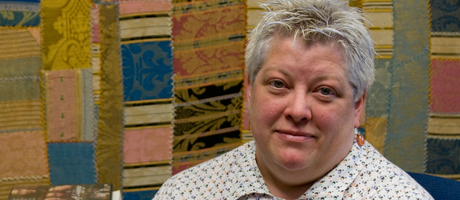Scattered diaries in homes. Scribbles in the margins of books. Writings on loose-leaf paper. While most of the 163,000 Jewish people in the Lodz Ghetto in Poland perished during the Nazi era, their words continue to haunt us.
The items left behind include an album created by children, wishing the Jewish elder Chaim Rumkowski a happy New Year. Thousands of names are listed in columns: Fela Rubin, E. Nelwyer, Goldberg.
Hoping to keep the ghetto residents’ spirits and stories alive, students in GW Professor of English Cayo Gamber’s University writing class are working with the United States Holocaust Memorial Museum to research the names, looking for any details of who these children were. Where did they live? How old were they? Where did they go to school? How did they die?
“This project asks us to hold each individual dear, to bear witness to one person’s life,” says Dr. Gamber. She notes that in one of the journals found in the Lodz Ghetto, a little boy wrote about his struggles in Polish, Yiddish, Hebrew and English, while sporadically adding words in German and French.
“It’s haunting to see the efforts they take for people to remember them, to hear them. It was as if he was reaching out to anyone who could understand,” says Dr. Gamber. “People were dying, but they were still writing, trying to show us that they were there, that they did exist.”
Currently in development, the Children of the Lodz Ghetto Memorial Research Project is part of an overall effort by the Holocaust Museum to recover the life histories and fates of children trapped in the ghetto. Dr. Gamber became involved after attending a two-week seminar that introduced the museum’s research Web site to scholars across the country.
Dr. Gamber became involved after attending a two-week seminar, organized by David Klevan, the museum’s education manager, which introduced the museum’s research Web site to scholars across the country. The site, linked to numerous data sources, allows researchers to track progress, make notes online and monitor other people’s work.
After Dr. Gamber’s students and a few others test the site, the Holocaust Museum will launch a worldwide collaborative volunteer project to find out what happened to the student signatories in the album. Currently, 1,500 of the 13,000 names are listed on the site. Over time, the goal is to add all the names.
Taking advantage of a research opportunity rare for first-year undergraduates, Dr. Gamber’s 45 students enthusiastically began digging through genealogy databases, hospital records, digitized ledgers, and death certificates and simply “Googling” names.
The work is helping students develop strong research skills and to learn how to effectively support their claims and critically analyze ways to improve the project’s research methods. At the end of the semester, each will write a paper about the project’s larger mission, how people understand history and how, as student researchers, they contributed to the historical record of those whose lives were profoundly affected by the Holocaust.
In the past semester, students scoured the Internet for information on more than 500 people, finding full information on the lives and/or deaths of only 10. “That’s one of the sad truths of the Holocaust. People just disappeared,” says Dr. Gamber. “They went up in smoke and ash. There will be no closure for many of these names.”
The difficulties in finding any conclusive information, however, make the successes even more rewarding. Within the first hour of research, students typed in one of the names. Entries popped up on their screen. This person had testified years ago about her experiences in the ghetto. She was one of the few who escaped with her life.
While for privacy reasons students could not contact her, they felt deep gratification in writing the details of her life — during her time in Lodz and after — on the Holocaust Museum’s Web site. With these details, they ensure that her story will be remembered. Their work promises that the people in the Lodz Ghetto will not be forgotten.


